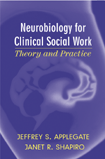 |
|
| Druckversion |
|
|
| Neuvorstellung | zur Übersicht | |||
|
14.07.2008 Jeffrey S. Applegate & Janet R. Shapiro: Neurobiology for Clinical Social Work. Theory and Practice |
||||
|
||||
|
Norton & Company
Andreas Manteufel, Bonn: Der Titel verspricht, dass in der Flut der Literatur zur Neurobiologie ein allgemeinverständliches Buch für den Praktiker erschienen ist. Wie setze ich neurobiologisches Wissen in therapeutische oder beraterische Tätigkeit um? Wie verändert es meine Praxis? Solche Fragen hätte man gerne beantwortet, und um es gleich zu sagen, dies gilt auch nach der Lektüre des zur Rezension vorliegenden Buches. Allerdings: Das Kriterium der Allgemeinverständlichkeit kann als erfüllt betrachtet werden. Das sprachliche Niveau ist angenehm konkret, Fachbegriffe werden verständlich erläutert. Für eine Einführung in die Hirnforschung sind aber Bilder enorm hilfreich, und darauf verzichten die Autoren leider fast gänzlich. Dass keine wirklich neuen psychotherapeutischen Interventionen aus der Gehirnforschung abgeleitet werden, wissen Applegate und Shapiro und sagen dies bereits in der Einleitung erfreulicherweise auch klar. Eher, so argumentieren sie, findet der Praktiker aufgrund seines Wissens um neurobiologische Zusammenhänge Kriterien für die Auswahl seiner Interventionen. Nach einer neurobiologischen Kurzeinführung werden die Themen Gedächtnis, Affekt und vor allem Affektregulation, Bindung, Prävention und Behandlungsstrategien abgehandelt. Das Niveau der neurobiologischen Darstellungen entspricht dem aktuellen Forschungsstand und ist in seiner Tiefe dem angezielten Leserkreis absolut angemessen. Immer wieder werden kleine Fallvignetten eingestreut. In ihrer Kürze suggerieren sie – das ist ihr Dilemma – Leichtigkeit und manchmal sogar Banalität. Das gesamte Kapitel über „Neurobiology Applied“ ist dem Buch „The Neuroscience of Psychotherapy“ von L. Cozolino angelehnt, das bereits in dieser Zeitschrift besprochen wurde. Wie so oft ist im Zweifel das Original vor zu ziehen. Durchgängig fokussieren die Autoren auf das „soziale Gehirn“ und die Bedeutung früher Bindungserfahrungen. Damit wird schnell eine Brücke zur beraterischen oder therapeutischen Beziehungsgestaltung geschlagen und die Bedeutung der ersten Lebensjahre hervorgehoben. Und damit sind natürlich die ältesten Tugenden in unserem Metier angesprochen! Seltsam mutet auch in diesem Buch die Kluft zwischen der Begeisterung für die Fortschritte in der Neurobiologie („this exciting new field of inquiry“) auf der einen und dem Mangel an Neuem bei der Frage nach den Praxisimplikationen auf der anderen Seite an. Was fehlt, und das gilt für die meisten Publikationen in diesem Feld, ist eine kritische Auseinandersetzung mit den Methoden der funktionellen Bildgebung und der brüchigen methodischen Basis, auf der so viele Experimente beruhen, deren Ergebnisse aber wie selbstverständlich überall referiert werden. Auch die Auseinandersetzung mit den Begrenzungen neurobiologischen Erkenntnisgewinns oder den Gefahren, in einseitig biologische Krankheitskonzepte zurück zu fallen, vermisst der Rezensent in diesem Band völlig. Es ist daher ein Buch wie viele andere, so sympathisch der Beziehungsansatz, der hier vertreten wird, auch ist. Information: gut. Kritische Reflexion: Fehlanzeige. (mit freundlicher Erlaubnis aus systhema 3/2006) Hier geht es zum Inhaltsverzeichnis und zum Vorwort des Buches Verlagsinformation: The last fifteen years have produced an explosion of research on the neurobiology of attachment. This research, which explores the ways in which affect regulation play key roles in determining the structure and function of the developing brain and mind, has led to a revolution in the way that parent-child relationships are viewed. Although these insights have informed psychiatry as well as cognitive and psychoanalytic psychology, their application to social work practice, education, and research has been lacking. Here for the first time ever, social work educators Jeffrey Applegate and Janet Shapiro demystify neurobiology and present it anew with the social work audience specifically in mind. Social workers, by virtue of their work with at-risk children and families, occupy a unique position from which to employ this new research in prevention and intervention. This lack of education about neurobiology has unfortunately fostered misconceptions among social workers that these theories are too academic and thus irrelevant to clinical practice. Neurobiology for Clinical Social Work corrects this misconception and introduces social workers to the powerful and practical ideas that are coming out of neurobiological research. The research summarized here offers new insights about the crucial role that relationships play in human development and in professional helping efforts. To set the stage for this inquiry, the authors introduce fundamentals of brain structure, development, and functioning in the first parts of the book. This introduction is intended as a primer and proceeds from the assumption that many readers are relatively unfamiliar with the field of brain science. Building on this foundation, the authors go on to describe the manner in which memory and affect regulation are neuropsychological processes. The next chapters of the book delve into the concepts of attachment. Specifically, the authors are concerned with how precursors to attachment evolve during the earliest months of an infant’s life and how various attachment classifications (secure, insecure, disorganized) lead to affect regulation—the ability of a child to regulate emotion. Throughout the book these concepts are discussed in the context of what social workers face when trying to find explanatory structures for the ways in which early childhood experiences affect later life. Later chapters turn even more directly toward practice. Using case examples—including adolescent parents and their children, children with a depressed parent, and children of substance abusing parents—Applegate and Shapiro show clinicians how to make use of neurobiological concepts in designing treatment plans and interventions. One chapter contains three extended case examples, with commentary, representing the three most common intervention models taught in schools of social work—psychodynamic, cognitive-behavioral, and systemic. Various settings, such as community mental health, family service agencies, and child welfare, are also discussed. In order to be effective and meet the complex challenges of the twenty-first century, social work professionals must join with their colleagues in other disciplines in coordinated efforts to integrate and apply newly emerging knowledge toward the enhancement of human well-being. Neurobiology for Clinical Social Work is a great place to start this process of integration and learning. Inhalt: Chapter 1 The Brain: An Introductory Tutorial 1 Chapter 2 The Neurobiology of Memory 15 Chapter 3 Affect: Toward a Neuropsychological Integration 26 Chapter 4 Early Affect Regulation: Prelude to Attachment 40 Chapter 5 Attachment: The Relational Base of Affect Regulation 58 Chapter 6 Vulnerable Dyads: The Quality of Early Caregiving Relationships 82 Chapter 7 Infant Mental Health: From Understanding to Prevention 119 Chapter 8 Neurobiology Applied: Affect Dysregulation and Its Treatment 141 Chapter 9 Three Case Studies 160 Chapter 10 New Directions for Social Work Education 202 Über die Autoren: Jeffrey Applegate, Ph.D. is Professor of Social Work and Social Research at Bryn Mawr College. Trained in psychiatric social work at the Menninger Foundation, Applegate is coauthor of The Facilitating Partnership: A Winnicottian Approach for Social Workers and Other Helping Professionals. Janet R. Shapiro, Ph. D., is Associate Professor of Social Work and Social Research, as well as Director of the Center for Child and Family Well-Being, at Bryn Mawr College. She holds dual degrees in social work and developmental psychology, and is coauthor of Complex Adoption and Assisted Reproductive Technology: A Developmental Framework for Clinical Practice. |
||||
|
|||||
|
Besuche seit dem 27.1.2005:   |

